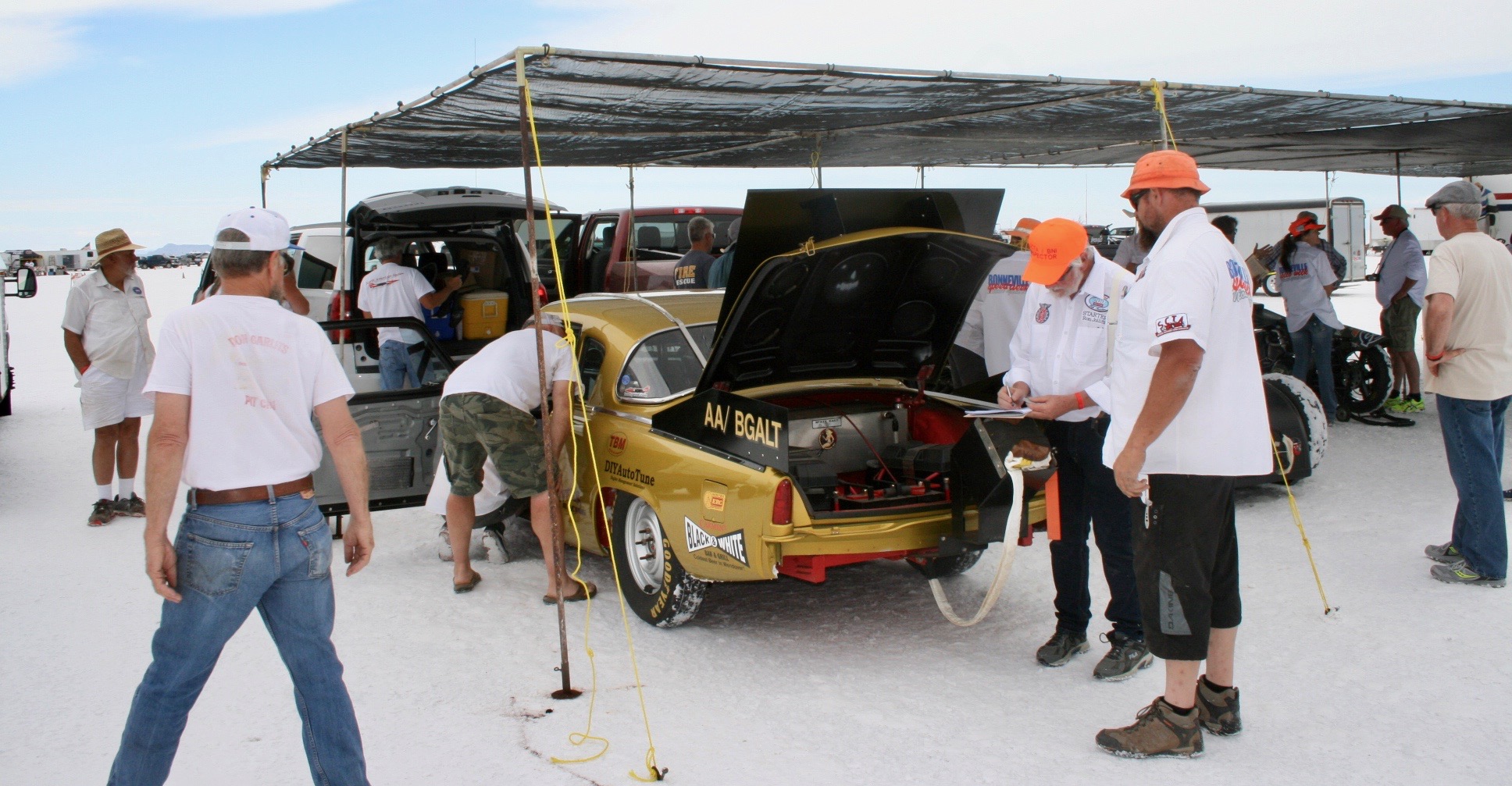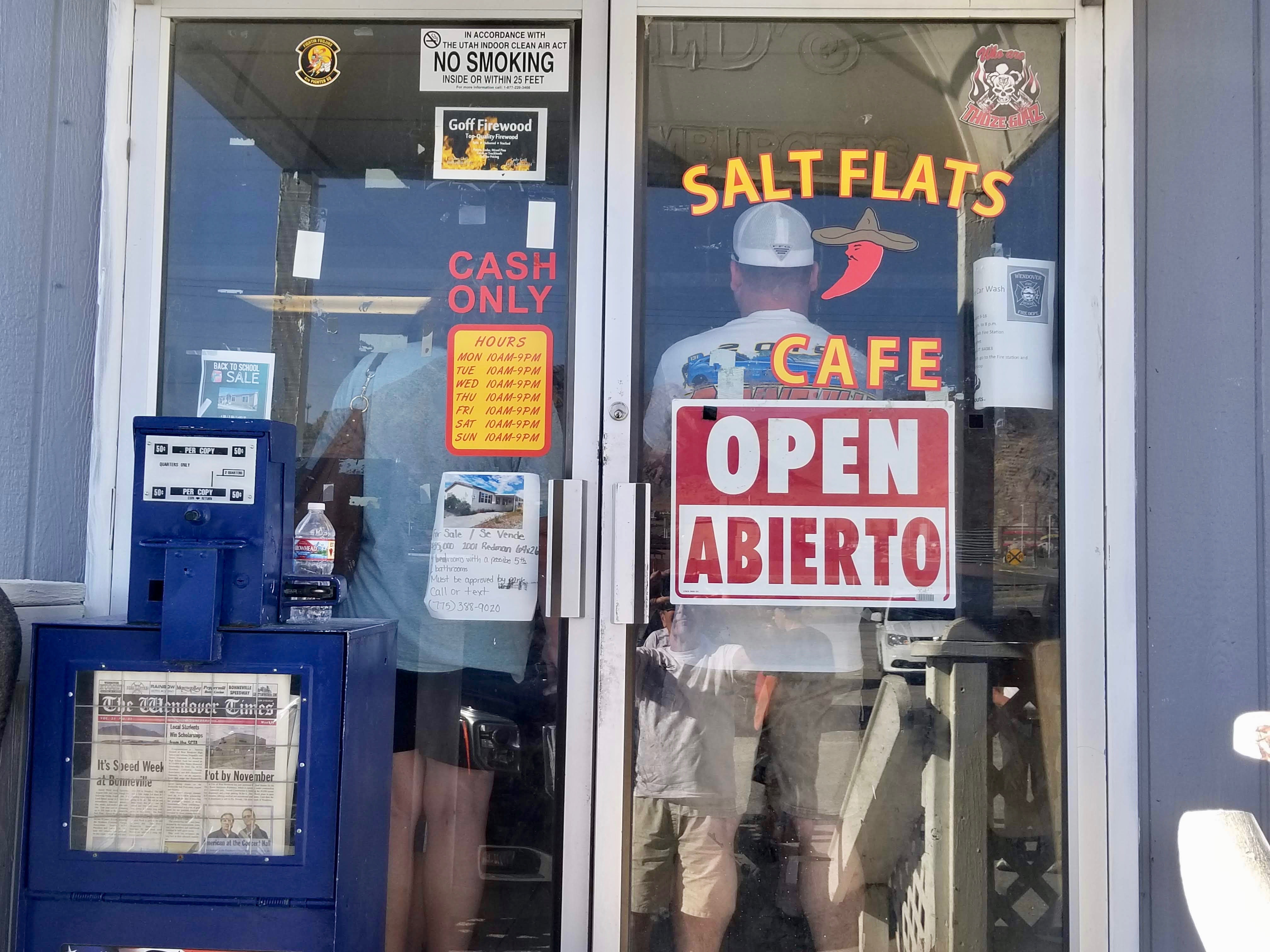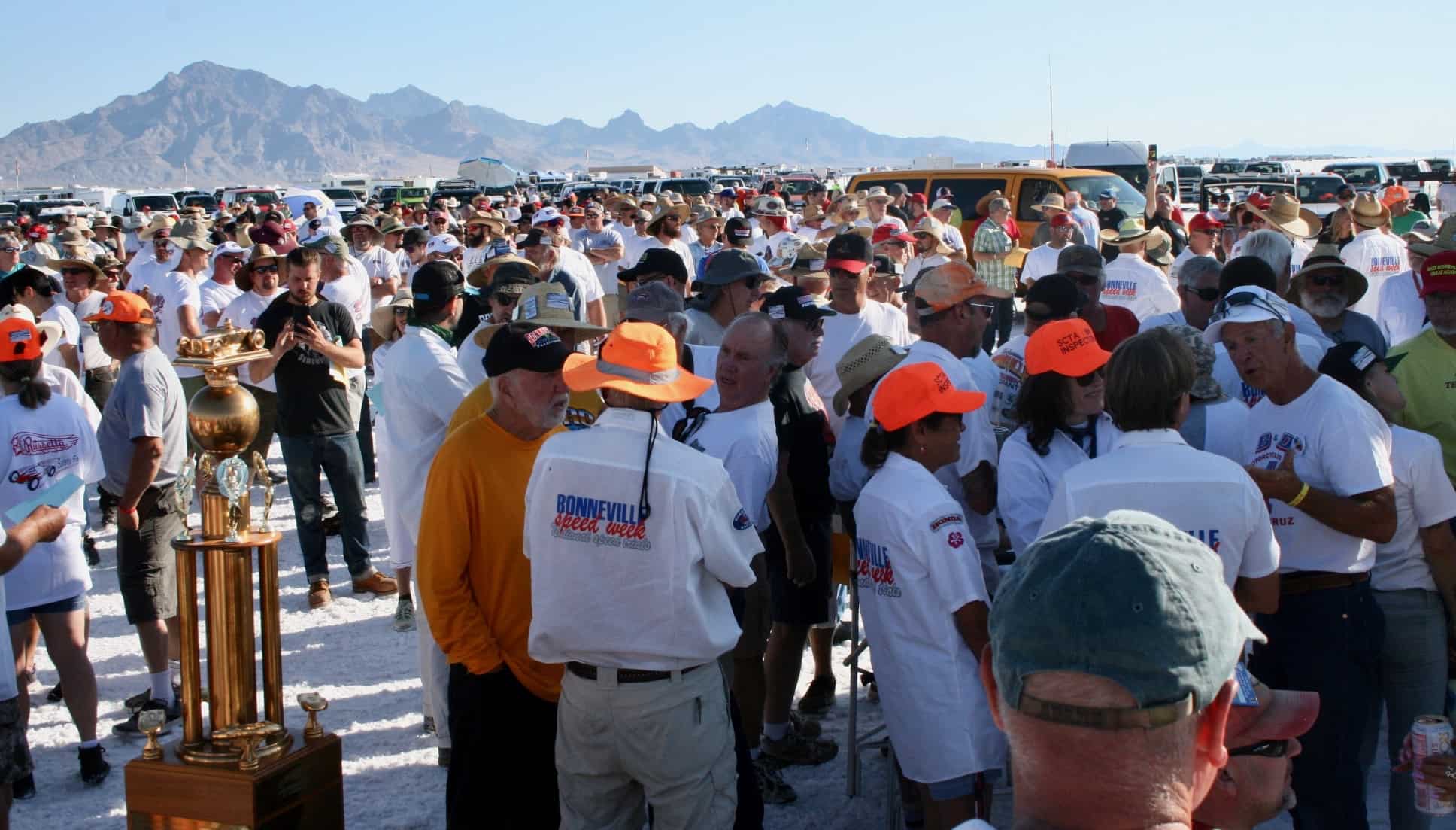Land speed racing enthusiasts are a strange breed. It seems no matter the problem or issue related to having the ability to satisfy their need for speed, they smile. Endlessly. Speed Week 2019 began with a positive outlook, but a brief shower on Bonneville’s International Speedway race course quickly delayed the schedule. And what was witnessed? Smiles.
The 71st Southern California Timing Association speed event began Thursday, August 8 with racers flocking to the salt flats outside Wendover, Utah, in all manner of machines with a single purpose: Ride or drive as fast as possible on carefully curated 3- to 8-mile straight courses.
The SCTA organizes upwards of 180 volunteers who come from many parts of the country to get racers and the race courses into proper form so speed records can be challenged in more than 80 car and truck classes and more than two dozen motorcycle classes. The event regularly draws several hundred competitors and 2019 was no exception.


Racers arriving on Thursday were able to get a jump on the tech process, lining up in multiple lines while SCTA inspectors went over each entry vehicle, noting new rules and giving owners, drivers and team members their first taste of what it was like out on the salt.
All participants are required to leave the salt flats by 8 p.m. each evening and just as racers began to exit the area Thursday, the clouds let loose with a drenching that everyone saw coming over the mountains from the west. Heading to the entry road was a sprint as no one wanted to be caught out on the salt surface, which softens quickly in these rainstorms.
Spectators and racers make use of the “bend in the road” camping area located just south of the race area, though the cloudburst managed to make that space mushy. Campers had to be extra cautious.
Many participants headed into nearby Wendover, which is basically cut in half with one side in Utah and the other in Nevada, with the Nevada side hosting a group of casino/hotels that always appeared to be very busy.


No one seemed to be too concerned that evening, though there were rumors swirling that the rain might delay the start of racing more than a day or two.
The required driver/team member meeting took place Friday at 9 a.m. with SCTA president Bill Lattin providing the update on salt conditions. He couldn’t provide a positive outlook, but said the SCTA staff was hard at work monitoring all aspects of the three courses including the course surface and turn out areas. He said there was hope that racing might commence Sunday morning (not Saturday) and everyone would be kept apprised of the conditions.
Scanning the hundreds present revealed lots of red 200 MPH caps and groups taking the news with a continued positive attitude. “That’s racing!” many could be heard saying as the crowd slowly moved off the salt and toward the pit area where race vehicles waited. It was promising to be a long wait.
Sunday arrived and Lattin again messaged the race teams saying there was simply too much moisture in the salt, making it dangerous to even consider letting anyone onto any of the courses. The weather, which was surprisingly pleasant with temperatures in the mid to high 80s, wasn’t drying things as hoped. The wait continued.

So, what do 500+ race participants do with their time while they look longingly at the great white salt? They gather in pit areas, swap stories and renew friendships, moving from pit to pit and generally accepting their lot. Some teams managed to do some needed work on race vehicles while others just stayed out of the relentless sunshine. After all, that’s racing!
Each morning during those few days of waiting you could find 100 or so speed maniacs at the Salt Flats Café, downing eggs, bacon, loads of coffee and enough stories to create a complete encyclopedia of hot rodding. The café staffs up each year and pulls a line of tables together to let the hungry hordes come in and essentially take over the place with talk, maybe a bit of loud boasting and lots of laughter. Wait… there’s those smiles again.
The evenings weren’t much different except many of the racing herd gathered in one of the parking lots of the Wendover Nugget Casino/Hotel those nights where a bevy of hot rods came together to provide another venue for speed discussion, comparing histories and gawking at some of the innovation that made up the collection of wheeled iron. Everything from traditional rods (some driven from as far away as New York) to an over-the-top ’68 Dodge Charger that appeared to have come directly off the movie set of Mad Max. You had to wonder where all these rods came from, but they offered a welcome respite from waiting for the salt to dry.

Unfortunately, the wait extended through the following Monday and Tuesday, but interestingly the tech area continued to see racers coming into the event looking for their opportunity to make a trip down the salt.
By Wednesday morning the SCTA staff felt two of the courses (the long 8-mile course and the rookie 3-mile course) were ready and racers lined up on the road leading onto the salt flats by 5 a.m. At 6:30 a.m. the 2-mile line of vehicles was allowed in and the race was on to get lined up at each of the two courses. Racing was scheduled to begin at 7:30 a.m. and everyone was ready.
Starters and other course officials took their positions and the long course opened with a 125cc motorcycle making that first run with much cheering and celebration. Racing had begun.
Throughout Wednesday racers, team members and spectators listened to the radio broadcast announcing each participant coming off the line on both courses with drivers and riders reporting slick conditions, requiring many racers to pedal the throttle as wheels spun and lost traction. In several runs there were spin outs. As the racing stretched into the afternoon, those spin outs seemed to increase and multiple motorcycles went down, including LowBrow Custom’s Tyler Malinky who laid his bike down at somewhere around 120 mph, breaking a wrist and sending Malinky home for the duration of the event.
Those spins and spills finally ended the racing for the day about mid-afternoon and racers were allowed to leave vehicles on the salt to hold spots for the following day. SCTA staff worked during the night to move the long course over about 100 feet so racers could have a fresh surface on Thursday.

Despite the course conditions, there were several record qualifiers Wednesday and they were allowed to get on the salt right away Thursday morning so they could make their second runs. Under SCTA rules you must run a second time on the same course and within the same flying mile. Once those qualifiers took their record runs the participants from the day before got to run, though the course continued to record slower speeds than last year, when Team Vesco’s Turbinator II exceeded 463 mph. Thursday morning, George Poteet and his Speed Demon posted the fastest run of the day, 369.533 despite the slick conditions.
Thursday turned out to be the final day of the week’s racing with 246 runs made on both the long and rookie courses. There was disappointment, of course, but land speed racers are a strange breed and they’ll be back on the salt again next year. Smiling all the way.






The Rain on Thursday prior to event starting didn’t cause the event to rain out. The 30 plus years of mining away the salt Did! I was there from across the country with 2 entries. Although seeing fellow racers and sharing camaraderie is all we can do at that particular point and it makes for a nice news article, I’m very upset about it! We need more action to Save The Salt!